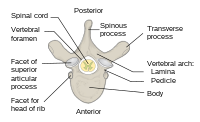
Photo from wikipedia
Introduction/Background It has been reported that passive elevation of the scapulae significantly decreases neck pain and increases cervical range of motion. However, it is unknown whether upper cervical rotation is… Click to show full abstract
Introduction/Background It has been reported that passive elevation of the scapulae significantly decreases neck pain and increases cervical range of motion. However, it is unknown whether upper cervical rotation is influenced by different scapula positions or not. The study used a 3D digitizer to determine three-dimensional motion analysis of the 2nd cervical (C2) spinous process at end range cervical rotation with the scapula in different positions. Material and Method 30 healthy adults (21.2 ± 0.8 years) participated in this study. Different scapula positions were adopted bilaterally and passively placed at (1) normal resting position, (2) depression, (3) adduction (4) abduction, with a neutral gleno-humeral joint in sitting. Under each scapula position, bilateral end range cervical rotation (degree) and displacement of the C2 spinous process [mm] were analyzed by a 3D digitizer device. End range rotation was analyzed by the vector from the left to right mastoid of the occipital bone related to the vector from the left to right acromial angle. Displacement of the C2 spinous process was calculated as the change in distance between the mastoid process and the point of intersection from perpendicular line from the C2 spinous process to the line between both mastoids at neutral and end range of cervical rotation. Results The results of our study indicate that there were no significant differences between end range cervical rotation and displacement of the C2 spinous process relative to the occiput in any scapular position. However, displacement of the C2 spinous process relative to the occiput was significantly correlated with range of cervical rotation under all scapular positions (P Conclusion Flexibility of upper cervical rotation would be influenced on end range cervical rotation regardless of scapular positions.
Journal Title: Annals of Physical and Rehabilitation Medicine
Year Published: 2018
Link to full text (if available)
Share on Social Media: Sign Up to like & get
recommendations!